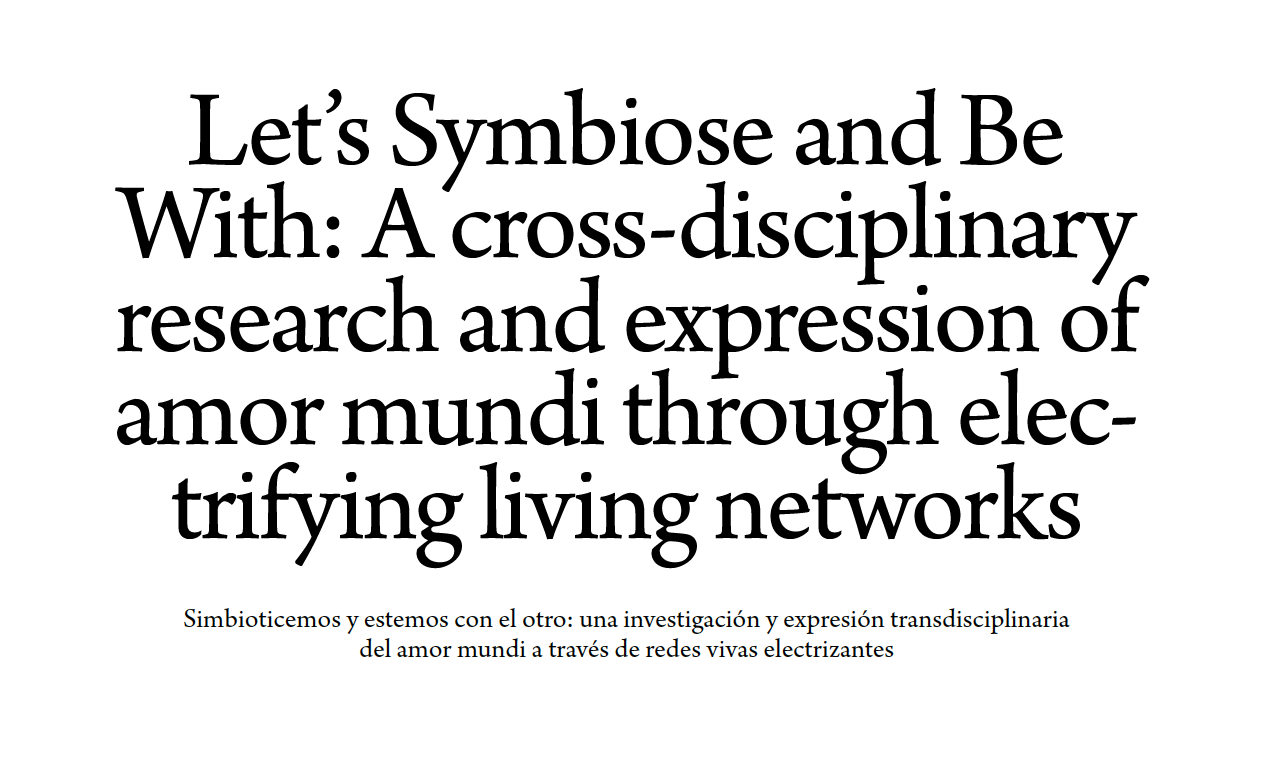Let's Symbiose and Be With. A cross-disciplinary research and expression of amor mundi through electrifying living networks
DOI:
https://doi.org/10.46516/inmaterial.v10.241Keywords:
Interdisciplinary, Cable Bacteria, art-science, bioelectricity, symbiosisAbstract
The sand of the seafloor is filled with electricity. Although it has been like that for millions of years, only about a decade ago, a group of Danish researchers found out that a microscopic hair-like bacterium is responsible for it. These so-called cable bacteria make electrical wires to transport energy over their bodies – a formerly unknown form of life. This unique creature has made scientists excited, intrigued and … in love. The bacterium attracted a lot of interested minds to Denmark. The fascination for cable bacteria crosses all fields of knowledge, initiating the collaborative project between art and science and thus giving the opportunity for different audiences to feel connected to the subject, regardless of their profession or background. The result was an exciting collaboration between scientists Robin Bonné and Jean Manca, and artist Anna Pasco Bolta, to create an art performance where a cable bacterium was fished from the mud and a love letter was read through a cable bacterium. Through the joint cross-disciplinary love letters of artist and scientists, they express their shared amor mundi, love for life and the world, together with their concerns and critical questions related to the fragile connections between life and the world. The cross-fertilisation of this scientific and artistic research connects fundamental questions on biosphere and technosphere, life, love and technology, symbiosis through electrical networks in nature and in our connected digital world. The artwork travelled around Europe, Canada and Egypt, and included a performance in front of 1500 microbiologists.
Downloads
References
Barnett, H. (2023). Drawing out the superorganism: Artistic intervention and the amplification of processes of life. In G. Anderson-Tempini and J. Dupré (eds) Drawing Processes of Life: Molecules, Cells, Organisms (pp. 193–218). Intellect Books.
Bjerg, J. J., Lustermans, J. J. M., Marshall, I. P. G. et al. (2023). Cable bacteria with electric connection to oxygen attract flocks of diverse bacteria. Nat Commun, 14, 1614. https://doi.org/10.1038/s41467-023-37272-8
Bonné, R., Hou, J. L., Hustings, J., Wouters, K., Meert, M., Hidalgo-Martinez, S., Cornelissen, R., Morini, F., Thijs, S., Vangronsveld, J., Valcke, R., Cleuren, B., Meysman, F. J. R., & Manca, J. v. (2020). Intrinsic electrical properties of cable bacteria reveal an Arrhenius temperature dependence. Scientific Reports 2020 10:1, 10(1), https://doi.org/10.1038/s41598-020-76671-5
Bonné, R., Wouters, K., Lustermans, J. J. M. & Manca, J. v. (2022). Biomaterials and electroactive bacteria for biodegradable electronics. In Frontiers in Microbiology (Vol. 13). Frontiers Media S.A. https://doi.org/10.3389/fmicb.2022.906363
Bonné, R., Marshall, I. P. G., Bjerg, J. J., Marzocchi, U., Manca, J., Nielsen, L. P., Aiyer, K. (2024). Interaction of living cable bacteria with carbon electrodes in bioelectrochemical systems. Appl Environ Microbiol90:e00795-24. https://doi.org/10.1128/aem.00795-24
Clark, S. E., Magrane, E., Baumgartner, T., Bennett, S. E. K., Bogan, M., Edwards, T., Dimmitt, M. A., Green, H., Hedgcock, C., Johnson, B. M., Johnson, M. R., Velo, K. & Wilder, B. T. (2020). 6&6: A transdisciplinary approach to art–science collaboration. BioScience, 70(9), 821–829. https://doi.org/10.1093/biosci/biaa076
Dong, M., Nielsen, L. P., Yang, S., Klausen, L. H. & Xu, M. (2024). Cable bacteria: Widespread filamentous electroactive microorganisms protecting environments. In Trends in Microbiology (Vol. 32, Issue 7, pp. 697–706). Elsevier Ltd. https://doi.org/10.1016/j.tim.2023.12.001
Kjeldsen, K. U., Schreiber, L., Thorup, C. A., Boesen, T., Bjerg, J. T., Yang, T., Dueholm, M. S., Larsen, S., Risgaard-Petersen, N., Nierychlo, M., Schmid, M., Bøggild, A., van de Vossenberg, J., Geelhoed, J. S., Meysman, F. J. R., Wagner, M., Nielsen, P. H., Nielsen, L. P. & Schramm, A. (2019). On the evolution and physiology of cable bacteria. Proceedings of the National Academy of Sciences, 116(38), 201903514. https://doi.org/10.1073/pnas.1903514116
Linka, M. (n.d.). Thatsoundsmart. Retrieved March 27, 2025, from https://thatsoundsmart.com/
López del Rincón, D. (2016). Arte, biología y tecnología: Relaciones interdisciplinares en el laboratorio científico. Arte, Individuo y Sociedad, 28(2), 235–252.
Meysman, F. J. R. (2018). Cable bacteria take a new breath using long-distance electricity. Trends in Microbiology, 26(5), 411–422. https://doi.org/10.1016/j.tim.2017.10.011
Meysman, F. J. R., Cornelissen, R., Trashin, S., Bonné, R., Hidalgo-Martinez, S., van der Veen, J., Blom, C. J., Karman, C., Hou, J. L., Eachambadi, R. T., Geelhoed, J. S., Wael, K. de, Beaumont, H. J. E., Cleuren, B., Valcke, R., van der Zant, H. S. J., Boschker, H. T. S. & Manca, J. v. (2019). A highly conductive fibre network enables centimetre-scale electron transport in multicellular cable bacteria. Nature Communications, 10(1). https://doi.org/10.1038/s41467-019-12115-7
Nielsen, L. P., Risgaard-Petersen, N., Fossing, H., Christensen, P. B. & Sayama, M. (2010). Electric currents couple spatially separated biogeochemical processes in marine sediment. Nature, 463(7284), 1071–1074. https://doi.org/10.1038/nature08790
Pasco Bolta, A. (2024). Let's Symbiose and Be With [Artwork]. Haus der Kunst, Munich, Germany. https://annapascobolta.com/symbiose.html
Pfeffer, C., Larsen, S., Song, J., Dong, M., Besenbacher, F., Meyer, R. L., Kjeldsen, K. U., Schreiber, L., Gorby, Y. A., El-Naggar, M. Y., Leung, K. M., Schramm, A., Risgaard-Petersen, N. & Nielsen, L. P. (2012). Filamentous bacteria transport electrons over centimetre distances. Nature, 491(7423), 218–221. https://doi.org/10.1038/nature11586
White, E. B. (1976). Letters of E. B. White (D. L. Guth, Ed.). Harper & Row.

Published
How to Cite
Issue
Section
License
Copyright (c) 2025 Anna Pasco Bolta, Robin Bonné, Jean Manca

This work is licensed under a Creative Commons Attribution-ShareAlike 4.0 International License.






